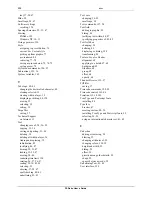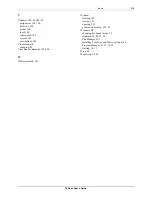
Glossary
229
FXDeko User’s Guide
screen space
Screen location is indicated on the status bar, expressed as either
world space or screen space.
World space, or resolution-independent space, is measured in
arbitrary units, selected by the user.
Screen space is a literal representation of the video frame buffer.
Screen space varies with the video standard: in NTSC 4x3, there are
720 horizontal pizels (called dots) and 486 vertical pixels (called
lines). These values can be found in
@dots
and
@lines
.
In Options/Preferences, choose Cursor Movement by Pixels for
screen space.
screen units
Screen units are the units FXDeko uses for the height of a typeface
and for the location of text and shapes in a graphic.
Screen units are user-definable, in Options/Preferences/Advanced/
Resolution. Once you set the number of vertical units, the number
of horizontal units is automatically set to 4/3 of that amount.
For convenience, the default value for screen units is 486 in NTSC
and 576 in PAL, which equals the number of visible scan lines in
each video standard.
search path
If FXDeko does not find a file in a current directory, it searches
each directory in the appropriate search path. There are four
different search paths based on file type:
graphics (.dko), sequences (.seq), automation (.aut)
styles (.sty), preset styles (.pst), shaders (.shd)
macros (.mcr)
motions (.mot)
sequence
A sequence is a list of events that controls the playback of a series
of FXDeko graphic files.
set width
A character’s set width determines how much horizontal space the
character occupies when typed. A character’s set width plus its pin
location equals the pin location of the character to its right.
shader
The shader controls the color — solid, texture, ramp, or keyhole —
of a detail or a background.
Summary of Contents for FXDEKO
Page 8: ......
Page 130: ......
Page 165: ...Macro Programming Language 165 FXDeko User s Guide b integer a 5 b equals 13...
Page 175: ......
Page 210: ......











































